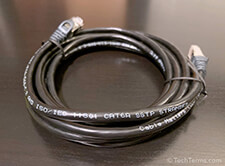Cat 6
Cat 6 (short for "Category 6") is an Ethernet standard. It operates at 250 MHz and supports data transfer rates of 10 Gbps. The maximum speed of Cat 6 is 10x faster than the previous standard, Cat 5e.
From the outside, Cat 6 cables look identical to Cat 5 and Cat 5e cables. They use the same RJ45 connectors and are backward-compatible with Cat 5/5e Ethernet networks. Internally, Cat 6 cables retain the same "twisted pair" wiring scheme with eight internal wires. The primary difference between Cat 6 and Cat 5 is that Cat 6 operates at 250 MHz, while Cat 5 and 5e operate at 100 MHz. The higher frequency enables Cat 6 cables to transfer data more quickly.
Cat 6 vs Cat 6a
Similar to Cat 5, Cat 6 has a variant with performance improvements. The variant is called Cat 6a (rather than Cat 6e). Cat 6a operates at 500 MHz, twice the frequency of Cat 6, but supports the same maximum data transfer rate of 10 Gbps. The difference is that Cat 6 can only transmit data at 10 Gbps for 55 meters (180 feet), while Cat 6a supports 10 Gbps for 100 meters (328 feet). A Cat 6 cable will still work over 55 meters, but the speed may decline.
While Cat 5e was the most popular Ethernet standard for nearly two decades, many modern LANs now use Cat 6 or Cat 6a cables. Even if the network equipment does not support 10 Gbps transfer speeds, Cat 6 cable is necessary to transfer data over 1 Gbps. Cat 6 cables are usually more expensive than Cat 5/5e cables, but re-running new Ethernet lines can be time-consuming and costly. Therefore, it is typically worth the extra expense to future-proof a network with faster Ethernet cables.
NOTE: Most Ethernet cables have the type of standard printed on the outer jacket.
 Test Your Knowledge
Test Your Knowledge